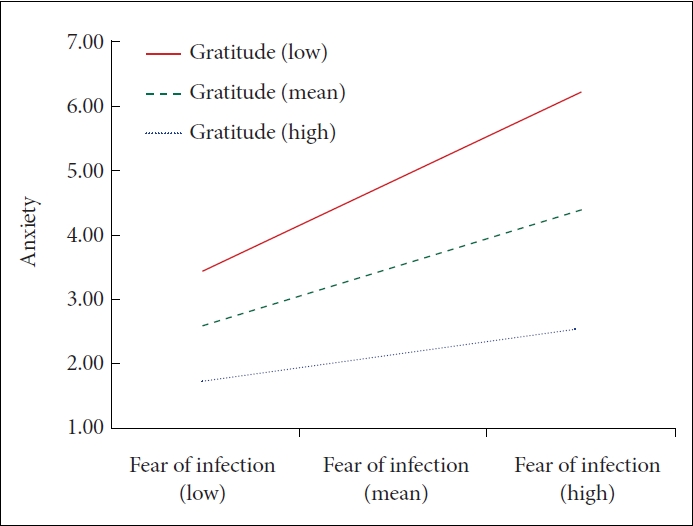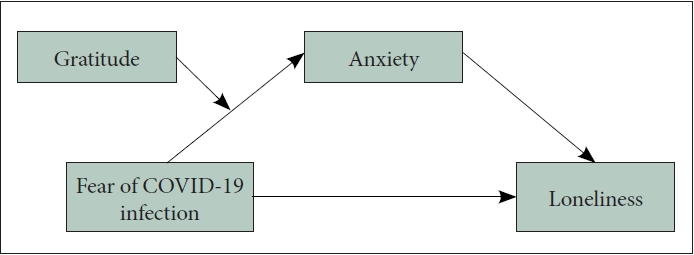2. Choi H, Choi H. Construct and measurement of the COVID-19 pandemic stress. Korean J Couns Psychother 2022;34:643-664.

3. Schimmenti A, Billieux J, Starcevic V. The four horsemen of fear: an integrated model of understanding fear experiences during the COVID-19 pandemic. Clin Neuropsychiatry 2020;17:41-45.


4. Lee DH, Kim YJ, Lee DH, Hwang HH, Nam SK, Kim JY. The influence of public fear, and psycho-social experiences during the coronavirus disease 2019 (COVID-19) pandemic on depression and anxiety in South Korea. Korean J Couns Psychother 2020;32:2119-2156.

5. Kim JM, Son JH. Effects of academic stress on non-dailiness experience on difficulties in online classes. Mediated effects of fear related to COVID-19. J Hum Rights Law Edu 2021;14:83-107.

10. Lee D, Kim J, Kang H. The emotional distress and fear of contagion related to Middle East Respiratory Syndrome (MERS) on general public in Korea. Korean J Psychol Gen 2016;35:355-383.

11. Lee JM. An exploratory study on effects of loneliness and YouTube addiction on college life adjustment in the distance education during COVID-19. J Korea Contents Assoc 2020;20:342-351.
12. Kayis AR, Satici B, Deniz ME, Satici SA, Griffiths MD. Fear of COVID-19, loneliness, smartphone addiction, and mental wellbeing among the Turkish general population: a serial mediation model. Behav Inf Technol 2022;41:2484-2496.

13. Perlman D, Peplau LA. Loneliness: a sourcebook of current theory, research and therapy. New York: Wiley; 1982.
15. Kim YJ, Nam S, Jung D, Lee DH. Korean’s loneliness during coronavirus pandemic: a latent profile analysis based on the biopsychosocial model. Korean J Soc Pers Psychol 2022;36:87-112.
18. Porcelli P. Fear, anxiety and health-related consequences after the COVID-19 epidemic. Clin Neuropsychiatry 2020;17:103-111.


21. Arslan G, Yıldırım M, Aytaç M. Subjective vitality and loneliness explain how coronavirus anxiety increases rumination among college students. Death Stud 2022;46:1042-1051.


22. Peterson C, Seligman ME. Character strengths and virtues: a handbook and classification. New York: Oxford University Press; 2004.
23. Jans-Beken L, Lataster J, Peels D, Lechner L, Jacobs N. Gratitude, psychopathology and subjective well-being: results from a 7.5-month prospective general population study. J Happiness Stud 2018;19:1673-1689.


24. McCullough ME, Emmons RA, Tsang JA. The grateful disposition: a conceptual and empirical topography. J Pers Soc Psychol 2002;82:112-127.


25. O’Connell BH, Killeen-Byrt M. Psychosocial health mediates the gratitude-physical health link. Psychol Health Med 2018;23:1145-1150.


26. Wood AM, Froh JJ, Geraghty AW. Gratitude and well-being: a review and theoretical integration. Clin Psychol Rev 2010;30:890-905.


27. Tedeschi RG, Calhoun LG. Posttraumatic growth: conceptual foundations and empirical evidence. Psychol Inq 2004;15:1-18.
28. Kashdan TB, Uswatte G, Julian T. Gratitude and hedonic and eudaimonic well-being in Vietnam war veterans. Behav Res Ther 2006;44:177-199.


29. Emmons RA, McCullough ME. Counting blessings versus burdens: an experimental investigation of gratitude and subjective well-being in daily life. J Pers Soc Psychol 2003;84:377-389.


33. Shin Y, Son E. The influence of emotional abuse experience on early adult depression, anxiety and interpersonal relationships: the moderating effects of gratitude. Korea J Couns 2017;18:239-261.

35. Spitzer RL, Kroenke K, Williams JB, Löwe B. A brief measure for assessing generalized anxiety disorder: the GAD-7. Arch Intern Med 2006;166:1092-1097.


36. Russell D, Peplau LA, Cutrona CE. The revised UCLA loneliness scale: concurrent and discriminant validity evidence. J Pers Soc Psychol 1980;39:472-480.


38. Kwon S, Kim K, Lee H. Validation of the Korean version of gratitude questionnaire. Korean J Health Psychol 2006;11:177-190.
39. Hayes AF. Introduction to mediation, moderation, and conditional process analysis: a regression-based approach. New York: Guilford Press; 2017.
40. Aiken LS, West SG, Reno RR. Multiple regression: testing and interpreting interactions. New York: Sage; 1991.
41. Park K. Women’s mental health and feminist therapy. J Korean Women’s Stud 2003;19:215-244.
42. Sloan MM, Haner M, Graham A, Cullen FT, Pickett JT, Jonson CL. Pandemic emotions: the extent, correlates, and mental health consequences of fear of COVID-19. Sociol Spectr 2021;41:369-386.

43. Yun JW, Wee H. A study on death anxiety, death preparation, gratitude and quality of life among Korean baby-boom generation women. J Korean Acad Psychiatr Ment Health Nurs 2016;25:207-216.


44. Gordon CL, Arnette RA, Smith RE. Have you thanked your spouse today?: felt and expressed gratitude among married couples. Pers Individ Differ 2011;50:339-343.

45. Aten JD, Smith WR, Davis EB, Van Tongeren DR, Hook JN, Davis DE, et al. The psychological study of religion and spirituality in a disaster context: a systematic review. Psychol Trauma 2019;11:597-613.


47. Rosmarin DH, Pirutinsky S, Greer D, Korbman M. Maintaining a grateful disposition in the face of distress: the role of religious coping. Psychol Relig Spiritual 2016;8:134-140.

48. Olson R, Knepple Carney A, Hicks Patrick J. Associations between gratitude and spirituality: an experience sampling approach. Psychol Relig Spiritual 2019;11:449-452.

49. Young JE. Loneliness, depression and cognitive therapy: theory and application. In: Peplau LA, Perlman D, editor. Loneliness: a sourcebook of current theory, research and therapy. New York: Wiley, 1982, p. 379-405.
50. Heinrich LM, Gullone E. The clinical significance of loneliness: a literature review. Clin Psychol Rev 2006;26:695-718.


51. Stravynski A, Boyer R. Loneliness in relation to suicide ideation and parasuicide: a population-wide study. Suicide Life Threat Behav 2001;31:32-40.


52. Coric D, Murstein BI. Bulimia nervosa: prevalence and psychological correlates in a college community. Eat Disord 1993;1:39-51.

55. DiTommaso E, Spinner B. Social and emotional loneliness: a re-examination of Weiss’ typology of loneliness. Pers Individ Differ 1997;22:417-427.

56. Watkins PC, Grimm DL, Kolts R. Counting your blessings: positive memories among grateful persons. Curr Psychol 2004;23:52-67.


57. Wood AM, Joseph S, Maltby J. Gratitude uniquely predicts satisfaction with life: incremental validity above the domains and facets of the five factor model. Pers Individ Differ 2008;45:49-54.

58. Wood AM, Maltby J, Gillett R, Linley PA, Joseph S. The role of gratitude in the development of social support, stress, and depression: two longitudinal studies. J Res Pers 2008;42:854-871.

59. Geraghty AW, Wood AM, Hyland ME. Attrition from self-directed interventions: investigating the relationship between psychological predictors, intervention content and dropout from a body dissatisfaction intervention. Soc Sci Med 2010;71:30-37.


60. Geraghty AW, Wood AM, Hyland ME. Dissociating the facets of hope: agency and pathways predict dropout from unguided self-help therapy in opposite directions. J Res Pers 2010;44:155-158.

61. Seligman ME, Steen TA, Park N, Peterson C. Positive psychology progress: empirical validation of interventions. Am Psychol 2005;60:410-421.


62. Watkins PC, Woodward K, Stone T, Kolts RL. Gratitude and happiness: development of a measure of gratitude, and relationships with subjective well-being. Soc Behav Pers 2003;31:431-451.

63. Kim K, Jo J, Kim D, Kim J. Objects, reasons, and effects of gratitude experienced by female adults. Korean J Couns Psychother 2009;21:191-208.
64. Pierce BS, Perrin PB, Tyler CM, McKee GB, Watson JD. The COVID-19 telepsychology revolution: a national study of pandemic-based changes in U.S. mental health care delivery. Am Psychol 2021;76:14-25.


65. Killen A, Macaskill A. Using a gratitude intervention to enhance well-being in older adults. J Happiness Stud 2015;16:947-964.













